

Steps to success for formal operations #year6 #maths. Mathsframe - Worksheets Resources. Can you design a number superhero? WIM2 has now released! 5 free mindset films and creative, open maths lessons. Please share! The Celebrating Maths Project close to 1K views: helping #parents & children connect with maths #homeschool #edtech. New display: commonly misspelt maths words Available to download and/or edit #TeamMaths. I've just been told about this free program that lets teachers create worksheets / quizzes. How can a child catch up to learn times tables in one term? Children should know all times tables by the end of year 4, but there are children that slip through the net, taking much longer to learn them.
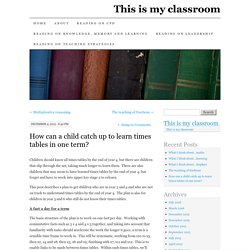
There are also children that may seem to have learned times tables by the end of year 4, but forget and have to work into upper key stage 2 to relearn. This post describes a plan to get children who are in year 3 and 4 and who are not on track to understand times tables by the end of year 4. The plan is also for children in year 5 and 6 who still do not know their times tables. A fact a day for a term The basic structure of the plan is to work on one fact per day. Multiple representations For times tables to stick and to be useful in other areas of maths, they need to be rooted in secure understanding. Using this we can explain that 4 x 5 means 5 lots of 4 and that by counting in multiples, we can find out that 4 x 5 = 20.
Creating Math Talk Communities. Twenty-one fourth graders are actively listening and constructively critiquing mathematical statements.
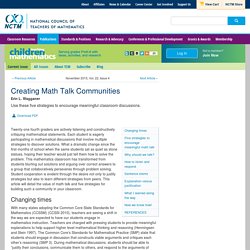
Each student is eagerly participating in mathematical discussions that involve multiple strategies to discover solutions. What a dramatic change since the first months of school when the same students sat as quiet as stone statues, hoping their teacher would just tell them how to solve the problem. This mathematics classroom has transformed from students blurting out solutions and arguing over correct answers to a group that collaboratively perseveres through problem solving. Student cooperation is evident through the desire not only to justify strategies but also to learn different strategies from peers. Tes Resources sur Twitter : "Looking for place value resources? Check out this handy search...
Shapes. Shape 16 from Andrew Gael Shape 17 Shape 18.

Puzzle Page. Each week we'll upload a brand new puzzle, taken from the extensive library of Mathematic Teaching Journals.
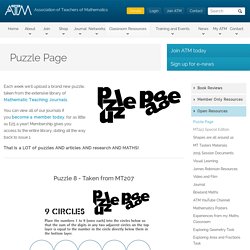
You can view all of our journals if you become a member today, for as little as £25 a year! Membership gives you access to the entire library, dating all the way back to issue 1. That is a LOT of puzzles AND articles AND research AND MATHS! La Salle Education - Pricing. Mathematics.
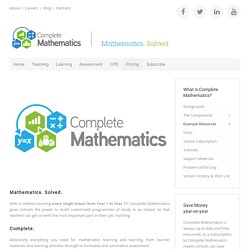
Solved. With a scheme covering every single lesson from Year 1 to Year 11, Complete Mathematics gives schools the power to build customised programmes of study in an instant so that teachers can get on with the most important part or their job: teaching. Complete. Absolutely everything you need for mathematics teaching and learning, from teacher materials and learning activities through to formative and summative assessment. 1001 Math Problems. Search. Graham Andre' sur Twitter : "#minions place value dice game with free Minions dice #primaryrocks #ukedchat #aussieED #math.
Jo Morgan sur Twitter : "#mathsgems If you don't already use do check it out. Lots of free maths resources available. Primary Maths. Resourceaholic.com provides ideas and resources for teaching maths to students aged 11 - 18.
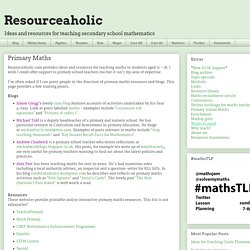
I wish I could offer support to primary school teachers too but it isn't my area of expertise. I'm often asked if I can point people in the direction of primary maths resources and blogs. This page provides a few starting points. Blogs Simon Gregg's lovely class blog features accounts of activities undertaken by his Year 4 class. Resources These websites provide printable and/or interactive primary maths resources. For more enrichment ideas, including information about in-school speakers and puzzle days, see my post 'Enrichment'. If you know of any good primary maths blogs or resources that I should feature here, please let me know by emailing resourceaholic@gmail.com.
Mastery Maths Shed. UKEdChat sur Twitter : "Book Review: The Numberverse by Andrew Day. NTU Primary Maths sur Twitter : "Math Solutions video Counting assessment. Danielle Bartram sur Twitter : "Display: FREE Shape bunting to download and make ready for the new year. Two types available. Fawn Nguyen sur Twitter : "Where @MathFireworks does a thorough review of Boaler's What's Math Got To Do With It? (updated version) Miss Brookes Maths. This post is just a short one about two-way tables.

I love teaching this topic, I find it to be such a nice topic with some lovely activities. To start with I love the free resources from Just Maths. There is a mini Whodunnit activity where pupils have to first fill in a sheet full of two-way tables, and then evaluate statements about the tables deciding which are true and which are false (Data sheet and Worksheet). This is a great activity and a wonderful way to get literacy into the lesson. I also love this "What's the Story? " Mathworksheetland have a Independent Practice Worksheet and a Matching Worksheet for using two-way tables. On TES there are some great resources, including this lesson from MrsKimMcKee. Daniel Burke has a great worksheet with lots of questions to practise filling in two-way tables. Using Questioning to Stimulate Mathematical Thinking. Good questioning techniques have long being regarded as a fundamental tool of effective teachers.
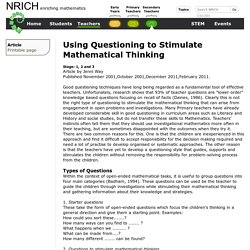
Unfortunately, research shows that 93% of teacher questions are "lower order" knowledge based questions focusing on recall of facts (Daines, 1986). Clearly this is not the right type of questioning to stimulate the mathematical thinking that can arise from engagement in open problems and investigations. Many Primary teachers have already developed considerable skill in good questioning in curriculum areas such as Literacy and History and social studies, but do not transfer these skills to Mathematics. Teachers' instincts often tell them that they should use investigational mathematics more often in their teaching, but are sometimes disappointed with the outcomes when they try it. Mark Gilbranch sur Twitter : "@rpd1972 seen these? Bloom's Taxonomy. Mastering the common problem types in maths. I’ve been wanting to combine some of the thinking I’ve been doing into cognitive overload, worked and partially completed examples, and the bar method as a pictorial representation of mathematical problems.

The lesson described below is what I did, with a substantial eye on the expectations of the new national curriculum and the idea of mastery. A worked example A good explanation clearly takes children through the steps needed in order to solve a problem, but these steps should be rooted in the deeper structure of a problem and not the superficial. As such, the success criteria that the teacher works from and that children refer to should support that expectation of analysis. In the example, I showed my class how they could solve a comparison problem where both the total of the parts and the difference between them is known, but the value of each part is not.
Cubeecraft.com. Hello and welcome to Cubeecraft template page!
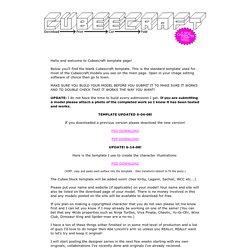
Below you'll find the blank Cubeecraft template. This is the standard template used for most of the Cubeecraft models you see on the main page. Open in your image editing software of choice then go to town. Dr Richard Farrow sur Twitter : "@bryngoodman @MGilbranch... NTU Primary Maths sur Twitter : "Ordering Cards : Target Numeracy sur Twitter : "Game packs on eBay starting at £5. #primaryteaching #maths #numeracy #math... Times Tables in 10 minutes. Hexa Trex... Puzzle Rules. Luke Rolls sur Twitter : "@mathinyourfeet: Multiplication Towers. Tom Sherrington sur Twitter : "Resourceaholic: Ideas from Shanghai > Very interesting -esp on mental maths." 5 Maths Gems #2. Last week I promised I'd write a weekly post summarising the new teaching ideas I'd seen on Twitter. Afterwards I worried whether I'd have enough material to write about, but this week I wasn't disappointed.
Plenty of ideas were shared - here's five of them. 1. Revision Whispers. As I've said before, I'm always on the look out for engaging ideas for revision lessons. All teams have the same message. 2. Speaking of post-it notes, I like this 'What stuck with you? ' If you want more post-it note teaching ideas then check out 'Post-it addict? ' While I was doing research for my fractions blog post this week I discovered the blog Authentic Inquiry Maths which is full of good ideas, like T-charts for highlighting similarities and differences.
Ed Southall's (@edsouthall) tricky maths problems on his website solvemymaths.com are also really visually appealing and I look forward to using them to challenge and extend my students next year. 4. 5. So, some helpful thoughts from Jo Boaler. Tes Special Needs sur Twitter : "Use these clear cards with straightforward explanations and visual support to help teach multiplication using arrays. Paul Godding sur Twitter : "Can anyone place the numbers 1-9 into the 3x3 grid with the 7 given clues? Have a bit of fun and try it out.
Michael Tidd sur Twitter : "New National Curriculum Assessment Materials from the NCETM helping to teachers to identify mastery & depth in KS1/2. Gaz Needle sur Twitter : "Geometry can be mind blowing! #PrimaryRocks @grahamandre... Mr A sur Twitter : "Using split pins to help with rotational symmetry! #RotationalSymmetry...